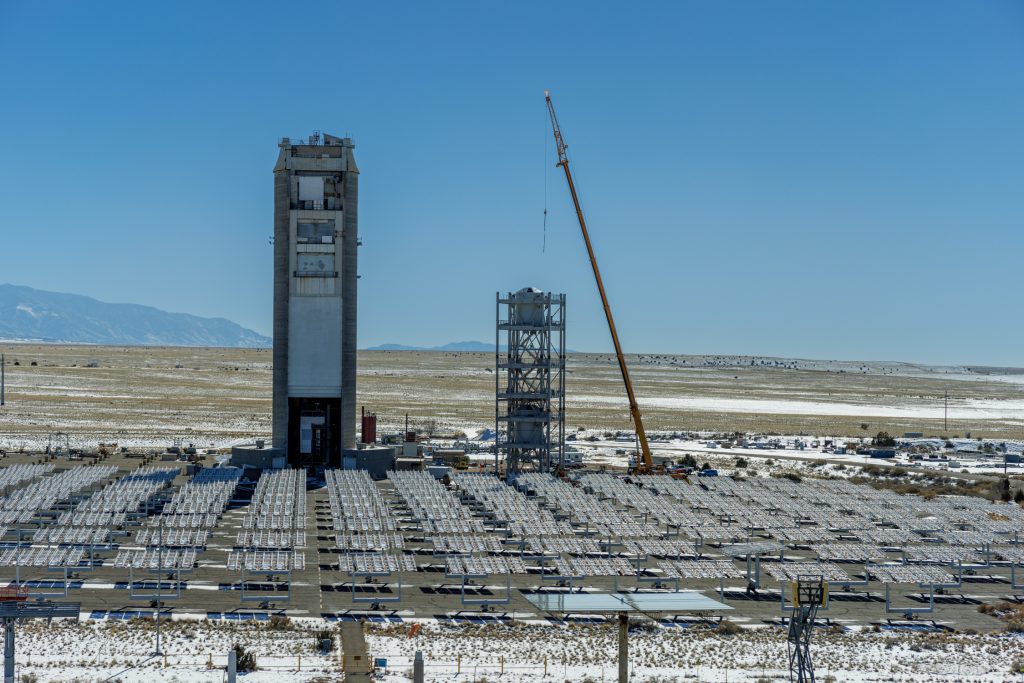
Solar Power Tower
The 200 ft. Solar Tower at Sandia National Laboratories provides 212 computer-controlled heliostats to reflect concentrated solar energy onto the tower, producing a total thermal capacity of 6 MW and peak flux up to 300 W/cm2.
The NSTTF offers a complete testing environment for a variety of activities, including:
• Thermal flash simulation
• Thermal performance testing and thermo-physical properties measurement
• Aerospace technology systems testing
• Solar array and solar applications testing
Solar Tower Features
- 4 – 350 sq. ft. test bays
- 1 – 750 sq. ft. test bay
- Elevating module brings tests from ground level to bay/roof
- Heat rejection system at each test bay
- Analog and digital data logger with multiple channels with variable frequency control
Heliostat Field
The 212 high-quality, individually computer controlled heliostats can produce high flux on target on the tower. The heliostats are also used for astronomy experiments, high temperature transient tests, material testing, thermo-nuclear test simulations, or radiation hardening experiments.
Heliostat Test Facility
This site provides setup and testing heliostats with special canting and focusing requirements. Various optical tools are available to cant and focus heliostats for various applications, including tracking and canting heliostats for near-earth stationary objects in space.
Assembly Building
The 2,500 sq. ft. warehouse/assembly building comes with a 34 ft. ceiling. The building includes a 5 ton mobile crane with 24 ft. lift, welding and machining tools.
Generation 3 Particle Pilot Plant (G3P3)

The U.S. Department of Energy awarded $25 million to Sandia to build, test, and demonstrate a next-generation concentrating solar thermal power plant at the National Solar Thermal Test Facility.
The objectives of the Gen 3 Particle Pilot Plant (G3P3) project are to design, construct, and operate an integrated system that de-risks a next-generation, particle-based concentrating solar power (CSP) technology to produce clean, utility-scale electricity with long-duration energy storage. The proposed multi-M Wt G3P3 system will utilize the existing field of heliostats at Sandia’s National Solar Thermal Test Facility (NSTTF) to concentrate the sunlight to a particle receiver that heats particles to over 700 °C, enables at least six hours of particle-based energy storage, and heats a working fluid (e.g., sCO2 or air) to ≥ 700°C while demonstrating the ability to meet cost and performance goals.
Particle receivers are being pursued to enable higher temperatures (>700°C) with direct storage for next-generation dispatchable concentrating solar power (CSP) plants, process heating, thermochemistry, and solar fuels production. Unlike conventional CSP receivers that use fluids flowing through tubes, the proposed particle-receiver system uses solid particles (ceramic or sand) that are heated directly as they fall through a beam of concentrated sunlight. Once heated, the particles are stored in an insulated bin before passing through a particle-to-working-fluid heat exchanger to power a high-efficiency Brayton cycle (e.g., sCO2 or air). The cooled particles are collected and then lifted back to the top of the receiver.
The success of this work will retire the primary risks associated with particle receivers and enable the successful demonstration of a high-temperature particle pilot plant that meets the U.S. Department of Energy’s SunShot goals with thousands of hours of on-sun testing. Successful operation of G3P3 will lead to broader acceptance, deployment, and commercialization.